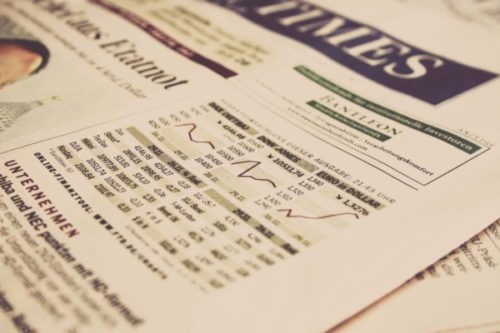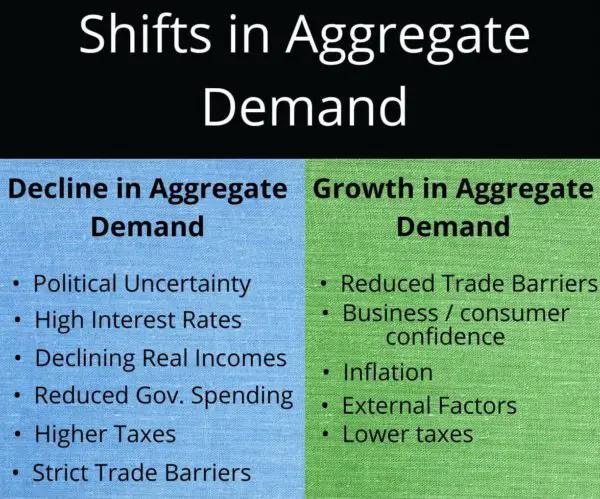Aggregate Demand: Definition, Components & Examples
What is Aggregate Demand?
Aggregate demand refers to all the goods produced and brought within the economy. Economists calculate this using values at a specific point in time, registered over the course of a month, quarter, or year.
It covers demand for products and services, measured using the money we exchange for them. So when a consumer purchases a Starbucks Coffee, that counts as aggregate demand. Cinema tickets count, a meal at Applebee’s counts, or even a new fridge. Put simply, aggregate demand is virtually anything we buy.
Key Points
- Aggregate demand refers to the demand of all goods and services produced in the economy.
- Aggregate demand is made up of four components – consumption, investment, government spending, and net exports (exports – imports).
Difference between Aggregate Demand and GDP
Aggregate demand is a macroeconomic term that measures the total demand in the economy at a certain time over a set period. In fact, Gross Domestic Product (GDP) is very similar.
Both measure the number of goods and services a nation produces. However, whilst aggregate demand measures the value and money exchange for goods and services, GDP measures the supply. In other words, GDP measures everything that is produced, but not sold. By contrast, aggregate demand measures everything that is both produced AND sold. Thus, when adjusted for the price level, GDP and aggregate demand align in the long-run.
In the long-run, there is no difference in value between the two. With that said, there is a clear difference in terminology. For instance, when describing aggregate demand, we are referring to total demand. In other words, the number of products and services that everyone wants.
With that said, it only refers to MET demand. You may go to the local supermarket to buy 6 doughnuts, but they only have 5. It sells you 5 doughnuts and that comes under aggregate demand. Even though 6 doughnuts are in demand, only 5 classify.
“The difference between the two is solely on terminology. Whilst GDP refers to supply, aggregate demand refers to MET demand. In the long run, they are essentially the same.”
By contrast, GDP refers to exactly what a nation supplies and produces in the economy. It is impossible to identify what each person would demand at any one point. What’s more, it is even more difficult to quantify it on a nationwide scale.
Economists consider everything purchased as a good demanded. By extension, everything that is not demanded is not included. In other words, if a consumer pays for it, it is demand. If it is not brought, it is not demanded.
Aggregate Demand Formula
Aggregate demand is just the met demand of a nations GDP – it is calculated using the formula: Aggregate Demand = Consumption + Investment + Government Spending + (Exports – Imports).

Components of Aggregate Demand
There are four main components of aggregate demand. They are consumption, investment, government spending and net exports (exports minus imports).
1. Consumption
Private consumption is by far the biggest component of aggregate demand. For example, in the US, it accounts for roughly 67 percent. This is driven by a number of factors, all of which have an impact on demand. We will look at these below:

Factors Affecting Consumption
1. Real disposable income
The more money people have, the more they are likely to spend. For example, if wages are increasing above inflation, demand will receive a boost as customers have an increasing level of disposable income. As disposable incomes increase, consumers will spend a proportion of this, thereby increasing consumption. At the same time, if inflation outstrips wages, consumers have less disposable income, which can cause consumption to contract.
2. Employment and job security
In uncertain times, such as the 2008 Great Recession, customers cut back on spending. That is because as consumers, they fear the security of their future income and employment. If people fear for their jobs, they are more prone to save than spend as they have obligations such as mortgage repayments and bills that need to be considered.
3. Household wealth
If there is a strong increase in house prices or general wealth, customers feel more confident as they feel richer. For example, prior to the 2008 Great Recession, house prices were sky-rocketing. As a result, households felt more prosperous, thereby increasing consumer confidence which transferred into demand. For example, households took out new mortgages on their homes in order to make new home improvements and other expenditures.
4. Interest rates
Interest rates can play a big part in creating consumer demand. For instance, lower rates mean less expenditure on mortgage repayments and lower levels of debt repayments. In turn, this can lead back to the first point: higher disposable incomes. When people have more money, they tend to spend more of it.
5. Fiscal Policy
If governments increase tax; there is less for consumers to spend. Consequently, this can have a depressing effect on demand. By contrast, if the government reduces tax, it can increase consumer income. In turn, higher consumer incomes will help boost consumption; at least in the short-term.
2. Investment
Private investment is an important aspect as it can help increase future demand. By investing in more productive machinery and equipment, workers are more productive. This means greater wealth in the economy. In turn, this creates a greater demand for other products and services.

Factors Affecting Investment
1. Expectations of future growth
If businesses expect demand to increase in the future, they will make the necessary adjustments to cater to such. For example, if a baker expects to sell 100 more loaves of bread next year, they may very well need to invest in a new oven.
2. Interest rate and availability of finance
Most businesses invest through loans or other forms of credit. So when interest rates increase, it makes a loan more expensive. From the businesses’ perspective; they have to be sure the return on investment is there. If the rate is 10 percent, they need to be sure that they will receive over that from new profits. Inevitably, the higher the rate, the more businesses are put off.
3. Wage increases
When there is a tight labour market, labour is in short supply. As a result, businesses react by offering higher wages to attract workers, At the same time, higher wage bills leave businesses with less to invest. This may increase demand in consumption, but lower demand in private investment.
4. Government policies
Increasing corporation tax, introducing new regulations, or even strict trade policies can all impact businesses’ desire to invest. Higher taxes mean owners receive lower profits, whilst higher trade barriers dis-incentivise increased capacity. With tariffs going up between China and the US; businesses may be unwilling to invest and expand production, in the uncertainty that international demand may not be there in future.
3. Government Spending
Government expenditure is often used as a way of stimulating aggregate demand. Also known as Keynesianism, governments use expenditure to stimulate the economy and demand. That is all very well, but what factors impact on government spending:

Factors Affecting Government Expenditure
1. Political environment
Election periods are usually times when the current government looks to boost the economy by spending more. By investing more and increasing demand, politicians aim to give consumers a ‘feel good’ factor before the election.
2. Economic Decline
During periods of economic decline, governments come under intense pressure to pump money in to stimulate demand and the wider economy. They often do this, but the levels of spending often remain long after the initial stimulus.
3. External factors
On rare occasions, there are strong external factors that force government’s hand. For example, wars are notable occasions, and on a smaller scale, we can look at local states of emergency. This could come through the devastation a hurricane has caused, or from a recent flood.
4. Fiscal constraints
Governments need to pay off their debts. If they do not receive enough through taxation, it makes it difficult to meet these obligations. As a result, governments must consider how much they are spending over and above what they receive. This is also known as the budget deficit.
4. Net Exports
Net exports can be crucially important to a nation’s economy. If domestic demand falls, a nation can rely on demand from abroad to help stimulate employment. So when aggregate demand falls in the US, the impact it has can be softened by aggregate demand abroad. However, a weakening of the US dollar may be needed for this to be achieved. So let’s see what factors affect net exports.

Factors Affecting Net Exports
1. Exchange rate
A strong domestic currency makes exports more expensive to foreign consumers. At the same time, it makes imports cheaper. This can boost aggregate demand as consumers can afford more.
2. Trade policy
If huge trade tariffs are put on imported goods, it makes such products more expensive. In turn, aggregate demand can decline because customers are paying more for the same amount of goods or services.
3. Geographic location
In some regions of the world, it is very difficult to build up exports. Location to other wealthy nations is key to boosting aggregate demand. If there is a domestic crisis, it is important to be able to rely on other surrounding nations to help stimulate aggregate demand.
Factors Affecting Aggregate Demand

Fall in Aggregate Demand
1. Strict trade barriers
Trade barriers can mean consumers have to purchase more expensive domestic products instead, potentially leading to a decline in consumption.
2. High Interest Rates
when rates are high, they can discourage spending. People have to pay more for their mortgage and more for any credit debt; leaving them with less to spend on consumption.
3. Declining real incomes
When inflation grows at a higher rate than real incomes, people have less to spend and can buy fewer goods with the same salary.
4. Reduced Government spending
As government spending is included in Aggregate Demand, a decline can affect demand. This may come after a consistent budget deficit, and therefore become necessary.
5. Higher Taxes
When taxes are higher, it means consumers have less money to spend. Consequently, there is less aggregate demand unless the money is equally spent by government.
6. Political Uncertainty
In situations such as Brexit in the UK, businesses and consumers are both unwilling to invest or make big purchases.
Increase in Aggregate Demand
1. Reduced trade barriers
When free trade is allowed, customers benefit from cheaper goods and services.
2. Business and consumer confidence
If both businesses and consumers are confident about the future, they may be willing to spend and invest more.
3. Inflation
If prices start to rise at a faster rate than consumers expect; they may increase their spending. The reasoning behind such is that they expect prices next year to be even higher than in the existing year. Therefore, they move purchasing decisions forward. This can boost Aggregate Demand, at least in the short-term.
4. External factors such as war, famine, natural crisis
In the short-term, governments may react to external factors and borrow billions to solve the situation. This can boost Aggregate Demand in the short term, but must be paid for in taxes over the long-term.
5. Lower taxes
When consumers have more money in their pockets, they are able to spend and demand more goods and services.
Related Topics
FAQs
Aggregate demand is an unnecessary term used to say total demand. In essence, it is everything demanded at a single point in time.
It covers demand for products and services, measured using the money we exchange for them. So that Starbucks Coffee you brought yesterday counts as aggregate demand. Or that cinema ticket you may have brought last month also counts.
Aggregate demand is made out of four components: Consumption, Private Investment, Government spending, and Net Exports (Exports – Imports).
Aggregate demand can be calculated by identifying the values of each of its components: consumption, private investment, government spending, and net exports. By adding these components together, we are then able to calculate aggregate demand.
There are a number of factors that affect aggregate demand. Examples include:
Business and consumer confidence
Inflation
External factors such as war, famine, natural crisis
Higher Taxes
High Interest Rates
Declining real incomes
About Paul
Paul Boyce is an economics editor with over 10 years experience in the industry. Currently working as a consultant within the financial services sector, Paul is the CEO and chief editor of BoyceWire. He has written publications for FEE, the Mises Institute, and many others.

Further Reading
 Medium of Exchange - A medium of exchange is a commonly accepted item or form of currency that is used to facilitate the buying…
Medium of Exchange - A medium of exchange is a commonly accepted item or form of currency that is used to facilitate the buying…  Stakeholder: Definition, With Internal & External Examples - A stakeholder is someone that has an interest in a business because its decisions affect them. These can either be…
Stakeholder: Definition, With Internal & External Examples - A stakeholder is someone that has an interest in a business because its decisions affect them. These can either be…  Human Development Index - The Human Development Index (HDI) is a composite measure that assesses a country's overall development based on indicators such as…
Human Development Index - The Human Development Index (HDI) is a composite measure that assesses a country's overall development based on indicators such as… 